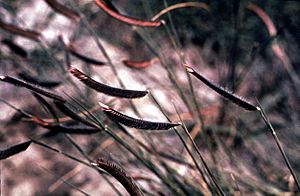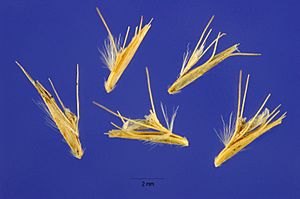Blue grama facts for kids
Quick facts for kids Blue grama |
|
|---|---|
 |
|
| Scientific classification | |
| Genus: |
Bouteloua
|
| Species: |
gracilis
|
The blue grama (scientific name: Bouteloua gracilis) is a type of grass that lives for many years. It grows best in warm weather and is native to North America.
You can find blue grama grass most often from Alberta, Canada, all the way east to Manitoba. It also grows south through the Rocky Mountains, across the Great Plains, and into the Midwestern United States. It even reaches the northern part of the Mexican Plateau in Mexico.
Blue grama is very important for the shortgrass prairie areas of the central and southern Great Plains. It helps produce a lot of the plant material there. This grass is usually green or grayish. It doesn't grow very tall and can handle dry weather well, needing little care.
Contents
What Blue Grama Looks Like
Blue grama grass has leaves that are green to grayish. They are less than 3 mm (0.1 in) wide and can be 1 to 10 in (25 to 250 mm) long. When fully grown, the whole plant is usually 6 to 12 in (15 to 30 cm) tall.
The stems that hold the flowers are 7 to 18 in (18 to 46 cm) long. At the very top, you'll see one to four, but usually two, comb-like spikes. These spikes stick out from the stem at a sharp angle. Each spike has many small parts called spikelets, usually between 20 and 90 of them.
Each spikelet is about 5 to 6 mm (0.20 to 0.24 in) long. It has one part that can make a seed (called a fertile floret) and one or two smaller parts that can't. If the flower is pollinated, the fertile floret produces a brown seed about 2.5 to 3 mm (0.10 to 0.12 in) long. When the seed is ready, the whole spikelet falls off.
The roots of blue grama grass usually spread out 12 to 18 in (30 to 46 cm) from the plant. They can also grow very deep, from 3 to 6.5 ft (0.9 to 2.0 m) into the ground.
Blue grama can grow from seeds, but it mostly spreads by growing new shoots from its base. Making seeds takes time and depends on how much water and warmth the soil has. Wind can carry seeds a few meters, but insects, birds, and mammals can spread them much farther. Young plants grow best when they are not too close to older plants, which use up a lot of the water in the soil. For new plants to grow well, they need a little bit of moisture in the soil as their roots develop.
Once blue grama plants are established, they can handle being eaten by animals, cold weather, and dry spells. However, if a drought lasts a very long time, their roots might shrink. These plants are good at using water quickly when it's available. They can also go into a resting state (become dormant) when conditions are not good. If an area is disturbed, blue grama grass grows back slowly. How fast it recovers depends on how much the area was disturbed.
Where Blue Grama Grows
Blue grama grass grows in more places than any other type of grama grass. It can grow in most kinds of soil and easily gets used to local weather. You can find it as far north as Alberta, Canada, and as far south as Mexico. It's common in most of the Midwestern United States, reaching east to Missouri and Texas, and west to Southern California. It has also been planted in some eastern states and in South America.
Uses of Blue Grama
Blue grama is very important as food for livestock like cattle. It's considered the most valuable grama grass for grazing animals in the southwest. It can survive heavy grazing and very dry conditions, and animals find it tasty. Letting animals graze on blue grama fields can also help stop unwanted weedy plants from growing.
People also grow blue grama in gardens. It's used in perennial gardens, in natural-looking landscaping, for projects that restore natural habitats, and to stop soil from washing away along roads and in neighborhoods. The flowers of blue grama are also used in dried flower arrangements. Blue grama is the official state grass of Colorado and New Mexico. However, it is listed as an endangered species in Illinois.
Some Native American groups have used blue grama grass in interesting ways. The Zuni people used bunches of the grass as hairbrushes and brooms. They also used it to strain goat's milk. The Ohlone people used the hollow stems as drinking straws. The Navajo people used it to feed their sheep and horses.
Blue Grama in Nature
Blue grama is the main type of plant found in the shortgrass steppe ecoregion in the US. Different groups of blue grama plants across the Great Plains have small genetic differences. These differences help them adapt to different climates. Blue grama from drier grasslands can also change their features more easily to suit their environment.
This grass is also a food source for the young (larvae) of several types of butterflies and skippers. These include the Garita skipperling, green skipper, Pahaska skipper, Rhesus skipper, Simius roadside skipper, and the Uncas skipper.
See also
 In Spanish: Chondrosum gracile para niños
In Spanish: Chondrosum gracile para niños




